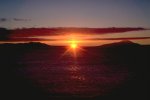|
|
|
 |
 |
 |
 |
 |
1. Only the male caribou bulls have antlers. (False)
Caribou are the only members of the deer family whose females as well as males grow antlers.
2. The Sierra Nevada Mountains are one of the mountain ranges found within the Porcupine Caribou migration
range. (False)
Three of the major ranges within the migration range are:
- Richardson Mountains
- Ogilvie Mountains
-
Chandalar MountainsLichen, caribou winter food
Photo courtesy USGS
3. The caribou's favorite winter foods are nuts and berries. (False)
Caribou search out and eat a plant called lichen that grows under the snow in their winter range.
4. Native Gwitch'in people have always used plastic beads, scrapers, and spoons. (False)
Traditionally the caribou taken in the hunt were almost completely utilized. Antlers were used to make many things,
including tools like scrapers and spoons. Porcupine quills were once dyed and used before traders brought plastic
and glass beads.
5. Karsten and Leanne, the "Being Caribou" team are migrating
with the herd. They are using snowmobiles for transportation. (False)
These adventurers are traveling on foot and by ski as they migrate
with the caribou on a 7 month expedition. Any loud machine like a snowmobile
would frighten the caribou.
6. Many native (aboriginal) people live off the land in the Arctic. (True)
As their tradition, many people in the Arctic continue to harvest their food off the land. Hunting, trapping, and
gathering continue to contribute necessary food and income for native people. In addition, the eco-tourism business
has grown as more people are interested in visiting and experiencing the beauty of the northern wilderness.
Explain your Answer
1. Why are the individual hairs in the caribou's fur hollow?
This is an adaptation. Caribou fur has hollow strands to help insulate them from the cold and keep them buoyant while swimming across rivers.
The Arctic Refuge is recognized as one of the finest examples of wilderness left on the planet. It is a place where wild has not been taken out of the wilderness. The Refuge has managed to maintain its natural condition, diversity of wildlife, and other special values. Management focuses on research, education, and monitoring. There are no manmade roads, trails, parking lots, or visitor centers in the Refuge.
3. Old Crow, Yukon Territory is a small town of about 300 aboriginal people located at the confluence of the Crow
and the Porcupine Rivers. If you wanted to visit, how would you get there in the summer? or during the winter?
Visiting Old Crow requires a fly in. In the winter it can be reached by snow machine or dog sled.
4. Carmen was not an old caribou when she was captured and collared
this spring. What are the best guesses about how she died?
It is thought that Carmen was killed by a predator. The most likely predator
would be a wolf.
5. Karsten Heuer and Leanne Allison have many reasons that they are
following the Porcupine caribou migration trail. What are some of their reasons?
Karsten and Leanne want to experience and understand one of North
America’s last great mammal migrations before it’s too late.
They are trying to make people aware of the impact of what might be lost
if the Coastal Plain of the Arctic National Wildlife Refuge is open to
oil development. They feel that the entire Arctic ecosystem, complete
with its people, would be put at risk and they want to educate others about
this possibility.
The wind off the Beaufort Sea keeps the mosquito and fly population lower on the coastal plain than inland. Animals, including newborn calves, have been known to be trampled by caribou gone crazy from too many insects attacking them. In addition, the food plants grow abundantly on the coastal plain during the summer months. Caribou, including lactating cows, gain back the weight they lost during the migration and bulk up for fall in this area rich in plant life.
7. Daylength has changed significantly in the Arctic since February. Calculate how much daylight there was on Feb. 4th. How many more hours of light do they have May 20th?
|
Date |
Sunrise |
Sunset |
Hours of |
|
02/04/03 |
10:18 |
16:50 |
6hr 32min |
|
05/20/03 |
2:47 |
23:51 |
21hr 4min |
 |
Copyright 2003 Journey North. All Rights Reserved.
Please send all questions, comments, and suggestions to our feedback form
|
|
|
|
|
|
|
|






